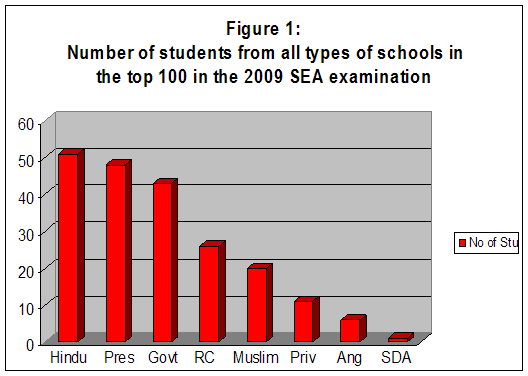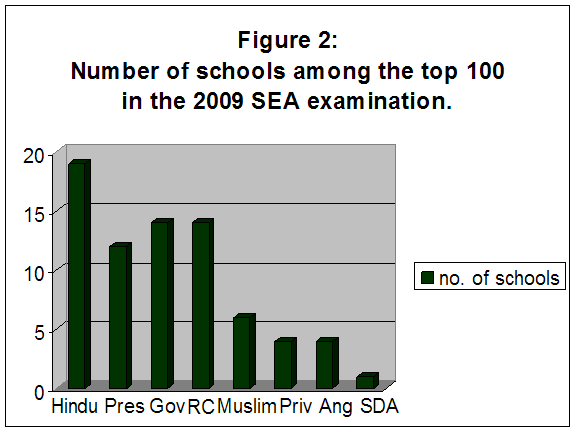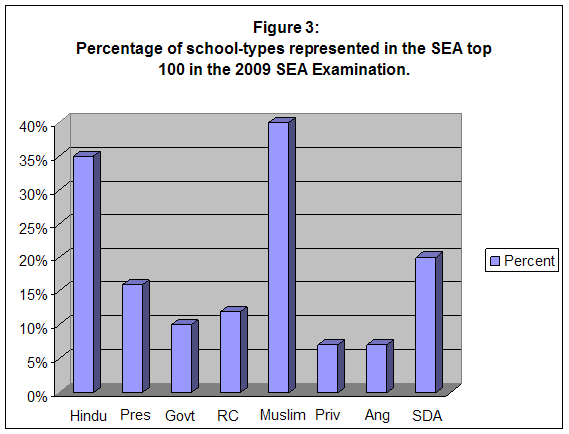Ashadh krushna Saptami, 5111
Press Release
By Dr. Kumar Mahabir
Most Hindu primary schools were established in rural Trinidad and Tobago in the Caribbean in the early 1950s by one man, Bhadase Sagan Maraj. He converted temples into schools on private lands that were donated by altruistic individuals and organizations. The cost of renovations, refurbishments and furniture was borne by the goodwill of members of the community. Today, these schools are a source of pride to Hindus.
The results of the 2009 SEA examination in 2009 reveal the largest number of students among the top 100 performers came from Hindu schools. Hindu schools comprise just 10 percent of all primary schools in the country, but secured 35 percent of the schools that made it to the top 100 places in the SEA examination. Among denominational institutions, Hindu schools performed the second best after Muslim schools.
A detailed analysis of the data reveals that Hindu schools out-performed the prestigious Presbyterian schools. They did three-and-a-half time better than the Government schools, and five times better than Private and Anglican schools.
 |
There is a total of 533 primary schools in Trinidad and Tobago comprising 54 Government-assisted Hindu primary schools. These Hindu schools consist of 43 primary centers managed by the Sanatan Dharma Maha Sabha (SDMS), nine by the Arya Pratinidhi Sabha (APS/Vedic), and two by the Kabir Panth Association (KPA). There are also eight Hindu secondary schools in the country administered by the SDMS, SWAHA and the Chinmaya Mission. There are also scores of Hindu Early Childhood Care and Education Centres.
Of all the different types of schools (denominational and government) in the country, the largest number of students among the top 100 SEA examination came from Hindu schools. The second largest number came from Presbyterian schools. This figure was followed closely by the Government schools. The smallest number of students appearing among the top 100 in the SEA examination came from the Seventh Day Adventist schools.
Among all Hindu primary centers of learning, the APS/Vedic schools are performing the best. Fifty-one students (25%) came from Hindu schools, forty-eight (23%) from Presbyterian schools, forty-three (21%) from Government schools, twenty-six (13%) from Catholic schools, twenty-one (10%) from Muslim schools, eleven (5%) from Private schools, six (3%) from Anglican schools, and one (1%) from Seventh Day Adventist.
APS/Vedic schools out-performed all other Hindu and denominational schools in this year’s SEA examination. APS/Vedic produced 13 students from four of its nine schools (44%) among the top 100 in the SEA examination. Muslims produced 21 students from six of its 15 elementary centers (40%), Maha Sabha produced 38 students from 15 of its 43 institutions (39%), and Presbyterians had 48 students from 12 of its 72 schools (17%).
Of all the APS/Vedic schools, Avocat Vedic turned out the largest number of bright students. However, it was Dayanand Memorial Vedic in Penal that produced Danielle Sieunarine, one of the two students who scored the highest mark in this year’s SEA national examination. Last year, Gandhi Memorial in Aranguez produced Ajay Rameshwarsingh who scored the highest mark.
Both denominational and government schools appeared among the top 100 in the 2009 SEA examination. Hindus had the most schools represented in the SEA top 100 with a total of 19. This was followed by a draw between the Government and Catholic schools which had 14 of their schools. Presbyterians had 12 of their schools represented, while the other school-categories had less than 10 of their schools represented.
 |
These statistics are not an accurate reflection of the performance of these school-types because the figures were not calculated as a percentage of the total number of schools in each category. For example, there are 54 Hindu schools in the country. Fifty-one of the top 100 students came from these 54 schools. Therefore, approximately 35 percent of Hindu schools were represented in the SEA top 100 listing. The two best-performing Hindu schools were Avocat Vedic and Rio Claro Hindu.
There is a total of 533 primary schools in Trinidad and Tobago comprising of 138 Government, 119 Catholic, 72 Presbyterian, 58 Private/Other, 56 Anglican, 54 Hindu, 15 Muslim, 10 Methodist, five Seventh Day Adventist, four Baptist, and two Moravian schools.
The statistical results vary when an analysis is done of the school-types appearing among the top 100 SEA examination as a percentage of the total number of schools in each category. In this analysis, Muslim schools performed the best. Hindu schools came second, while Seventh Day Adventist schools ran third. Presbyterian schools performed fairly on average. Government, Roman Catholic and Anglican schools fell short of expectations when considering the large number of schools they control. Among denominational institutions, Hindu schools performed the second best after Muslim schools.
 |
A total of 17,617 students wrote the Secondary Entrance Assessment (SEA) examination which is used to facilitate the placement of primary school students in secondary schools in the country.
Also See
 |
Learn & Practice Hinduism |
 |
Dharma Jagruti SabhasDhama Jagruti Sabhas is creating mass awareness among Hindus about various problems affecting Hindu Dharma. |




